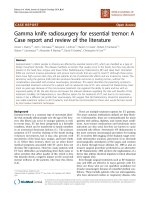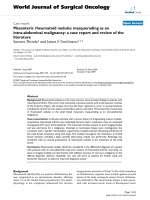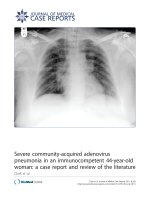Báo cáo y học: "Native valve endocarditis due to Micrococcus luteus: a case report and review of the literature" ppsx
Bạn đang xem bản rút gọn của tài liệu. Xem và tải ngay bản đầy đủ của tài liệu tại đây (386.65 KB, 3 trang )
CAS E REP O R T Open Access
Native valve endocarditis due to Micrococcus
luteus: a case report and review of the literature
George Miltiadous
1*
and Moses Elisaf
2
Abstract
Introduction: Micrococcus luteus endocarditis is a rare case of infective endocarditis. A total of 17 cases of infective
endocarditis due to M luteus have been reported in the literature to date, all involving prosthetic valves. To the
best of our knowl edge, we describe the first case of native aortic valve M luteus endocarditis in an
immunosuppressed patient in this report.
Case report: A 74-year-old Greek-Cypriot woman was admitted to our Internal Medicine Clinic due to fever and
malaise and the diagnosis of aortic valve M luteus endocarditis was made. She was immunosuppressed due to
methotrexate and steroid treatment. Our patient was unsuccessfully treated with vancomycin, gentamicin and
rifampicin for four weeks. The aortic valve was replaced and she was discharged in good condition.
Conclusions: Prosthetic infective endocarditis due to M luteus is rare. To the best of our knowledge, we report the
first case in the literature involvi ng a native valve.
Introduction
Micrococcus species are Gram-positive cocci that are
normal inhabitants of human skin tha t rarely cause
infectious diseases such as septic arthritis, meningitis
and prosthetic valve endocarditis [1-3]. In a Medline
database search of the literature the authors identified
17 previous cases of infective endocarditis due to Micro-
coccus species, all involving prosthetic valves. Thi s parti-
cular case is of parti cular interest in that it is a case of
infective native aortic valve endocarditis due to Micro-
coccus luteus. To the best of our knowledge, this is the
first such case to be reported [4,5].
Case presentation
A 74-year-old Greek-Cypriot woman was a dmitted to
our Internal Medicine Clinic because of fever and
malaise that had started a week previously. At three
weeks prior to her admission she had undergone a total
right knee replacement due to chronic osteoarthritis.
Also, 10 years earlier our patient had undergone total
mastectomy of the right breast and axillary lymph node
dissection, due to breast cancer. Sin ce then she had
been taking tamo xifen. Additionally, seven years ago a
giant cell arteritis had been diagnosed and she had been
taking 15 mg of methotrexate per day and pulses of
steroids. She had no recent history of dental work.
On admission, our patient was febrile (38.5°C) and
tachycardic (112 beats/minute). The chest was clear to
auscultation and a diastolic grade 3/6 murmur along the
right sternal border was detected on cardiac examina-
tion. Clinical examination of the abdomen showed noth-
ing remarkable. There were also no peripheral signs of
infective endocarditis or neurological deficit. Finally, her
recently operated right knee did not show any signs of
inflammation.
Laboratory test results revealed normochromic, nor-
mocytic anemia (hematocrit 33%), leukocytosis (white
blood cell count 12,000 cells/mm
3
, 80% neutrophils) and
mild thrombocytosis (platelet count 415,000 cells/mm
3
).
We also noted an elevated erythrocyte sedemetation
rate (ESR) (110 mm/hour), and C reac tive protein (CRP)
(200 mg/L) and rheumatoid factor (RF) (30 IU/mL)
levels. Liver function test results and serum creatine
levels were within normal limits and th e extracted urine
sample was normal with no signs of hematuria or casts.
On admission we conducted chest X-ray and upper
abdomen ultasonography, the results of which were nor-
mal. An electrocardiogram (ECG) showed a right bundle
branch block. Three subsequent blood cultures were
* Correspondence:
1
Hippocrateon Private Hospital, Nicosia, Cyprus
Full list of author information is available at the end of the article
Miltiadous and Elisaf Journal of Medical Case Reports 2011, 5:251
/>JOURNAL OF MEDICAL
CASE REPORTS
© 2011 Miltiadous and Elisaf; licen see BioMed Central Ltd. This is an Open Access article distributed under the terms of the Creative
Commons Attribution License (http ://creativecommons.org/licenses/by/2.0), which permits unrestricted use, distribution, and
reproduction in any medium, provided the original work is properly cited.
drawn over a period of one hour and two of them grew
Mluteus. Transthoracic echocardiography was per-
formed, showing a vegetation of about 1 cm on the aor-
tic valve (Figure 1). A diagnosis of infective endocarditis
wasestablishedaccordingtotheDukecriteria[6].In
fact, one major (valvular vegetation) and three minor
(fever > 38°C, elevated RF and positive blood cultures of
a microorganism that do not typically cause infective
endocarditis) criteria were met (of note, two months
earlier our patient’s yearly check-up had showed normal
plasma RF levels). In addition, during the course of the
disease our patient had a brain embolic event. There-
fore, an additional minor criterion was also met.
Our patient was treated initially with vancomycin, 2 g/
daily, and intravenous gentamicin, 240 mg daily accord-
ing to antimicrobial susceptibility. Due to acute renal
failure, gentamicin was discontinued nine days later and
replaced by 600 mg of rifampicin, After t wo weeks of
vancomycin and rifampicin treatment our patient was
still febrile up to 37.5°C. On the 30 th day of hospitali-
zation our patient again had a high fever, up to 39°C
with fever tremors, and showed dysarthria lasting about
three hours. A second Transthoracic echocardiography
was performed showing no differentiation. Apart from
the contaminated valve no other p ossible sources of
infection were identified through clinical examination.
Our patient was then referred to the cardiac surgery
department for aortic valve replacement. The biopsy of
the replaced valve showed the existence of granulation
tissue with signs of fibrotic repair and formation of sc ar
tissue. Our patient was finally discharged in good health.
Discussion
As reported by Seifert et al., M l uteus isararecauseof
infective prosthetic valve endocarditis[4]. The outcome
of Mluteusendocard itis and the op timum therapeutic
regimen remain to be further explored and defin ed. To
the best of our knowledge, this is the first case ever
reported concerning Mluteusendocarditis involving a
native valve. After an initial improvement, our patient
experienced recurrence of septicemia (even though not
documented by new blood cultures) and an embolic epi-
sode to the brain.
Our patient was immunosuppressed due to metho-
traxate treatment and a history of breast cancer.
Furthermore, our patient had an orthopedic operation
about three weeks before her admission to our clinic
and, thus, a bacteremia during the proce dure is a possi-
bility. This immunosuppression and the recently per-
formed surgery may be the causes of the infective
endocarditis.
Conclusions
To the best of our knowledge, we describe the first case
of Mluteusendocarditis involving a native valve in the
present repo rt. Therefore, clin icians shoul d be aware of
the rare possibility of M luteus native valve endocarditis.
Consent
Written informed consent was obtained from the patient
for publication of this case report and a ny accompany-
ing images. A copy of the written c onsent is available
for review by the Editor-in-Chief of this journal.
Figure 1 Transthoracic echocardiography, showing a vegetation of about 1 cm on the aortic valve.
Miltiadous and Elisaf Journal of Medical Case Reports 2011, 5:251
/>Page 2 of 3
Author details
1
Hippocrateon Private Hospital, Nicosia, Cyprus.
2
Department of Internal
Medicine, Medical School, University of Ioannina, Ioannina, Greece.
Authors’ contributions
GM was the internist in charge of our patient. ME was a major contributor
in writing the manuscript. All authors have read and approved the final
manuscript.
Competing interests
The authors declare that they have no competing interests.
Received: 20 August 2010 Accepted: 29 June 2011
Published: 29 June 2011
References
1. Kloos WE, Tornabene TG, Schleifer KH: Isolation and characterization of
micrococci from human skin, including two new species: Micrococcus
lylae and Micrococcus kristinae. Int J Syst Bacteriol 1974, 24:79-101.
2. Wharton M, Rice JR, McCallum R, Gallis HA: Septic arthritis due to
Micrococcus luteus. J Rheumatol 1986, 13:659-660.
3. Fosse T, Peloux Y, Granthil C, Toga B, Bertrando J, Sethian M: Meningitis
due to Micrococcus luteus. Infection 1985, 13:280-281.
4. Seifert H, Kaltheuner M, Perdreau-Remington F: Micrococcus luteus
endocarditis: case report and review of the literature. Zbl Bakt 1995,
282:431-435.
5. Uso J, Gill M, Gomila B, Tirado MD: Endocarditis due to Micrococcus luteus.
Microbiol Clin 2003, 21:116-117.
6. Dodds GA, Abramson MA, Corey GR, Kisslo J, Sexton DJ: Use of the Duke
criteria for the diagnosis on ineffective endocarditis. Lin infect Dis 1995,
21:448-449.
doi:10.1186/1752-1947-5-251
Cite this article as: Miltiadous and Elisaf: Native valve endocarditis due
to Micrococcus luteus: a case report and review of the literature. Journal
of Medical Case Reports 2011 5:251.
Submit your next manuscript to BioMed Central
and take full advantage of:
• Convenient online submission
• Thorough peer review
• No space constraints or color figure charges
• Immediate publication on acceptance
• Inclusion in PubMed, CAS, Scopus and Google Scholar
• Research which is freely available for redistribution
Submit your manuscript at
www.biomedcentral.com/submit
Miltiadous and Elisaf Journal of Medical Case Reports 2011, 5:251
/>Page 3 of 3









